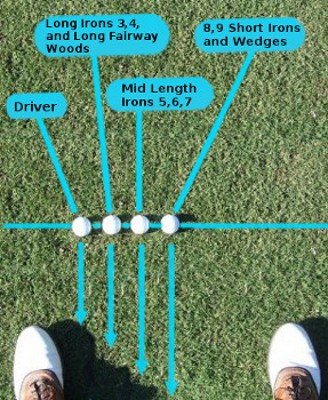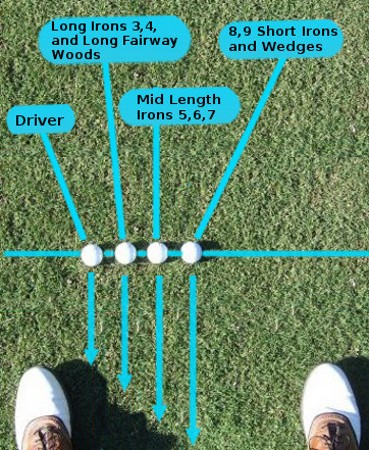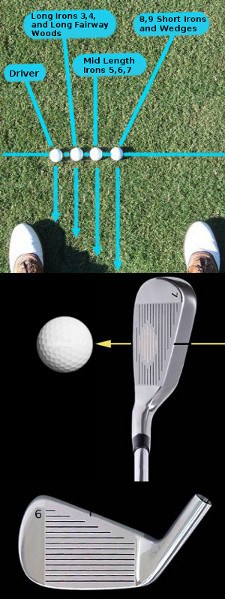
If your stance, posture and club length are all correct, but your ballstriking is weak, the solution could be as checking your golf ball position. Here’s a primer:
Let"s look at how ball position should vary based on the club type (playing from a flat lie):
Once you understand proper ball position basics for each club type, you can personally fine-tune your positioning. Swing each club and mark where it hits the ground in relation to your stance. Then place the ball at the beginning (back) edge of the mark. Your ballstriking will improve and you’ll hit fewer fat shots (club hitting ground first) and thin shots (bottom edge of the club hitting the middle or top of the ball).
Golf Ball Videos:
- Compression Video
- Spin Video
- Dimples Video
- Golf Ball Brands Video
- Titleist Video
- Understanding Spin Video

Dialing in the Perfect Golf Ball Position
There are a number of important fundamentals related to the golf swing, and proper ball position is certainly on that list. Correct golf ball placement at address is vital to the consistency of your performance on the course because you can only control your ball flight if you are putting the ball at the same point in your stance shot after shot. Many golfers struggle with inconsistent golf ball position, which puts them in an uphill battle to hitting good shots. You might think there is a problem with your golf swing itself because of the poor shots you are hitting, but the trouble could be hiding in your golf ball placement all along.
The problem for most golfers is that golf ball position, and golf setup position in general, just doesn’t seem that important. Most golfers focus the vast majority of their practice time on the swing itself, from the time the club starts moving back until the moment it strikes the ball. However, much of the quality of your swing has to do with what happens prior to ever starting the club in motion. If you are able to put yourself in a great position at address – and put the ball in the right position as well based on the club you are using – making a good swing instantly gets much easier. Most golf teachers can tell how good a player is just by watching them set up to the ball because it reveals so much about the swing that is about to happen.
Among the common ball position mistakes that golfers make is thinking that they can use the same golf ball position for different clubs. For the majority of players, that just isn’t going to work. When you learn how to adjust your golf ball position for different clubs, you will give each of those clubs the chance to perform at their best. Since all of your clubs are slightly different in terms of lie angle, loft, and length, it only makes sense that your ball position would vary as you move through your bag. It might seem like a lot of work to develop your own golf ball position chart for each club, but the effort will be worth it in the end. Knowing where you want to position the ball with each club, and then doing it time after time accurately, is something that can separate a good golfer from an average one.
When talking about golf ball placement in your stance, there are really two categories to deal with – woods and irons. Since the swing you use, and the kind of impact you make, with your woods and your irons is different, there are different rules that apply to the ball positioning you will look for. Try to keep the two separate in your mind and remember that what applies to ball position for irons isn’t necessarily going to be true with your woods.
It is important to note before we get started with the instruction on ball position that all of the directions below are based on a right handed golfer. For those of you who play left handed, please reverse the instructions to make sure they apply correctly to your game.

The Basic Idea
Just like anything else you do on the golf course, it is important to understand why you need to place the ball in the right position shot after shot. Only when you are clear on that point will you be likely to take the time and effort it requires to execute proper ball position all throughout a round.
It’s not breaking news that one of the main goals in your golf swing is to make solid contact with the ball at impact. With a driver, that means finding the sweet spot while the ball is sitting up on a tee. With your irons, that means hitting the ball with a downward impact just slightly before your club hits the ground and takes a divot. Without making solid contact at impact, you will have a hard time hitting the ball the right distance, and you will hit plenty of off-line shots as well.
So we know that making good contact is essential – but what role does ball position play in that process? Think about it this way. Imagine that you were playing basketball, and you were standing at the line shooting free throws. Which of the following would be easier – shooting free throws at a stationary basket, or one that was moving from side to side? Obviously, it would be easier to shoot free throws at a stationary basket. No matter what sport you are talking about, hitting a moving object is almost always going to be harder.
Inconsistent ball position is essentially a moving target for your golf swing to hit. If you stand over your shot on the second hole and the ball is in a different position than it was on the first hole, your swing is going to have to adjust. Could you make the adjustment and still hit a good shot? Sure, maybe. But you shouldn’t have to. Getting the ball in the right position on every single shot makes the work that your golf swing as to do that much easier.
Not having to swing at a ‘moving’ target is one great reason to work on your ball position. But there are others. For instance, if you hope to develop your game to the point where you can create different ball flights for different situations on the course, you will need to know how your ball position influences that skill. Placing the ball back in your stance farther will generate a lower ball flight, while moving it up an inch or two should help you get the ball higher in the air. Also, depending on the specific mechanics of your swing, moving the ball up or back can (or in or out) can also change whether you hit a draw or a fade.
To review, good ball position makes it easier for your swing to repeat correctly shot after shot, hole after hole. It allows you to hit a bigger variety of shots, and hit them with more consistency. Golf is a game where consistency is hard to find, so getting more of it in any way you can is always a good thing.

Ball Position for Woods
In this section, we are mostly going to be focused on getting the ball position right for your driver, but the basic idea remains the same for your three wood, five wood, etc. Because of the design of your driver, with a flatter lie angle than your irons, you want to swing it in a way that promotes a ‘flat’ impact with the ball. That means that instead of the club head moving downward through impact like it should be doing with your irons, the driver should contact the ball when it is moving roughly parallel with the ground. If anything, you actually want the driver head to be moving slightly back up away from the ground at impact, as that will give you the best chance at an optimal launch angle and carry distance.
To find the right ball position for your driver, head to the practice tee with your driver and plenty of balls to hit. You will also need an extra club that you can lay along the ground as an alignment aid. Place a golf ball on a tee, and then set your alignment club on the ground such that the grip of the club is pointed directly at the ball, forming a 90* angle with your target line. Now, take your golf setup position with that alignment club lying on the ground between your feet. To start with, the club should be just barely touching your left heel – that will mean that the ball is lined up with the inside of your left foot – perfect for most golfers when hitting a driver.
Try hitting a few shots from this traditional ball position and check the results. If the ball flight looks exactly like you want it, you are finished! This will be a successful ball position for plenty of golfers, so you might find that you don’t need to do anything else to optimize the ball position of your driver. However, some players may need to make a few more adjustments to find just the right spot.
If you notice that you are hitting most of the drives low on the club face in this position, that likely means that the club is moving back up too much at impact, and you need to move the ball back in your stance slightly. It is important to understand that a small change can lead to a big difference in results, so try moving the ball back in your stance only a little bit at a time until you find a good spot for your swing. Throughout the process, use your alignment club as a guide to make sure the ball is actually in the position that you think it is.
On the other side of the equation, you might need to move the ball up in your stance a little farther if you are hitting most of your tee shots too high on the club face. This is an indication that the club head is moving too much downward through impact, and your drives are probably floating high into the air and falling down relatively short. Slide the ball forward an inch or so at a time until you are able to hit the sweet spot of your driver swing after swing.
The great thing about working on your driver ball position is that the ground should be flat under your feet for every tee shot, meaning you won’t need to make any other adjustments to your ball position out on the course. Once you settle on the right spot for you and your swing, you can probably leave it alone and just work on becoming as consistent and repeatable as possible. As you will see in the next section, things are not so simple when it comes to your irons.

Ball Position for Irons
The ball position that you use for your irons is always going to be more important than it is with your driver. Make no mistake – it is still important with the driver – but it is absolutely essential when hitting iron shots off of the turf. If you are unable to find a good ball position for your irons, and then repeat it shot after shot, you are going to have very little chance of playing good golf on a consistent basis.
The proper ball position for an iron shot is right at the bottom of your swing arc, which should match up with your center of gravity at the point of impact. While that might sound pretty simple, actually getting the ball in that spot time after time is pretty complicated. The problem is that as your swing gets longer with your longer irons, the way your body works and moves in the swing will change. Therefore, you can’t use the same ball position for all of your irons and expect to get great results.
To get started working out a golf ball position chart for your irons, you should head to the practice range and start with the shortest club in your bag, other than the putter. For most golfers, this will be either a sand wedge or a lob wedge. Use the same trick with an alignment club from above and get the ball positioned perfectly in the middle of your stance – halfway between your right and left foot at address. This is going to be your ‘baseline’ ball position. Hit a few shots with the ball centered in your stance and see how it feels. Hopefully, this will be about right for you when hitting your shortest wedge.
Why start at the center of your stance? Because, we are hoping to match the ball position to the bottom of your swing, which should be right in the middle of your stance for a wedge. When hitting a short shot, you don’t want to have any noticeable lateral movement in your swing – it should all be rotational. So, the center of gravity that you have at the start of the swing should be approximately the same as it is at impact. Therefore, the middle of your stance should be the perfect ball position for your wedge shots.
As you move up through your set of irons, the ball should gradually move forward in your stance, a little bit at a time. With each club, this change in ball position should only be an inch or so, at the most. You will need to take time and care to find just the right spot in your stance, and use your alignment club to help you achieve this properly. Hit a few balls with each of your irons to make sure that the ball position you are using is going to produce a ball flight that you are happy with.
Your iron ball position should be a sliding scale that gradually moves from the center of your swing up toward the inside of your front foot. The longest iron in your bag should be the one that uses a ball position which is closest to your front foot. So, if your three iron is the longest iron you have, that ball position should be the farthest left as you look down from address. The progression in ball position from wedge to long iron should be smooth and gradual so that it can match the center of gravity in your swing at impact correctly.
Finding the perfect ball position with your irons is going to take some experimentation, and some practice. At first you are going to have to really think about each club and where the ball should be placed – but it should become more natural over time. In the final section we will discuss how you can make the process of finding the right ball position easier to it happens on the course without much thinking.

How to Make it Repeatable
It is one thing to be able to find a good ball position on the driving range and hit some quality shots during your practice sessions – but it is something else to do it on the course. When playing for real, you won’t be able to put an alignment club down on the ground to help you, and you won’t get multiple chances to get it right. You have to get your ball position right the first time, every time, if you are going to play your best.
In order to take what you have learned on the driving range with you out onto the course, you are going to need to have a pre-shot routine in place that helps you find your ball position. The following step-by-step system is one that many golfers use, and it is one of the easiest ways to make sure you are taking your stance in the right position.
While the instructions above might sound like a long and complicated process, it will get easier and faster with a little practice. In fact, you should try working through this routine before every shot you hit on the driving range as a way of ingraining it into your process. Even after just a few driving range sessions of working on this technique, you will find that your pre-shout routine is quickly a natural part of your game.
Proper golf ball placement in your stance is one of the fundamentals of the game that you just can’t afford to ignore. Spending time working on the moving parts of your golf swing is great, but it can all be wasted if you don’t get set up properly to begin with. Work on making your pre-shot routine and address position as consistent as possible, and you will likely find that your actual swing doesn’t need as much work as you thought it did. Golf ball position might not be the most exciting thing to practice, but you will put in the time if you are serious about finding lower scores out on the course.






